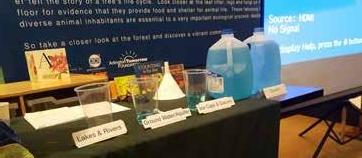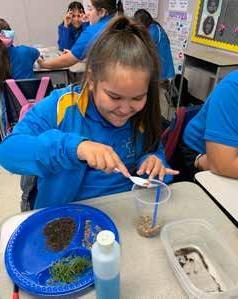
7 minute read
Conservation Legacy
Where Is Our Water?
An Insider’s Perspective
Article by ELISA VELADOR Photos courtesy of CONSERVATION LEGACY
Where Is Our Water? is one of the five Wildlife by Design presentations that L.A.N.D.S. Educators offer to teachers and students across Texas. This lesson covers topics that include the water cycle, water conservation, surface water vs. groundwater and aquifers.
Central to all Wildlife by Design presentations is a discussion of how we can be good land stewards for the benefit of our water, soil and wildlife especially on private land. Read on for an overview of how the water lesson is taught and what students learn.
THE WATER CYCLE
Students learn about the water cycle in their early elementary years, so this part of the presentation can be a brief review for older students, or each component of the water cycle can be explained in detail for younger students. Students are always amazed to learn that the same water the dinosaurs drank 65 million years ago, is the same water that humans drink today thanks to the water cycle.
Students learn that the sun drives the water cycle; it causes evaporation from bodies of water and from plants. The water vapor that is produced cools down in the atmosphere and forms clouds in the sky during condensation.
Water droplets get bigger in the clouds producing precipitation as rain, snow, hail or sleet. After precipitation falls on the earth it can become runoff or infiltrate through the soil and become groundwater. Students learn the difference between surface water and groundwater followed by the different water sources on earth.
WHERE IS OUR WATER?
Students are asked what the biggest source of water is. Most of them know that the biggest source of water is the ocean or salt water. Unfortunately, we humans are not adapted to drink salt water; we drink fresh water.
The next question is: What are the different sources of Earth’s fresh water? Students quickly answer that fresh water is found in rivers, lakes, streams and ponds. They are reminded about all the groundwater that is also fresh water and then they are asked one more question.
Where in the world can frozen fresh water be found? After thinking about the question, hands start to go up. “Icebergs?” a student asks. “Snow?” another student asks. Finally, someone says, “Glaciers!”
Yes, glaciers are a source of frozen fresh water and there is also a lot of frozen fresh water in the polar ice caps. These are all the places where water is found.
ALL THE WATER IN THE WORLD DEMONSTRATION
All the Water in the World is a great demonstration that shows the amount of water per category that is available on earth and how much is available for human use.
Three volunteers are secured from the group of students. Two gallons (7.57 L) of blue water are ready in a large container. This represents all the water in the world.

Using a measuring cup, one student volunteer will remove 1 cup (236.5 ml) from the container and pour it into a clear cup labeled “Fresh Water.” Students learn that this is only 3 percent. What is left behind in the large container represents all of the salt water which is 97 percent of all the water.
Another student volunteer removes 2/3 cup (162.5 ml) of water from the clear cup labeled “Fresh Water” and will pour it into a cup labeled “Ice Caps and Glaciers.” This represents 2 percent of the Earth’s water. This means that most of the fresh water in the world is frozen or trapped as ice and not easily accessible to most people.
The remaining 1/3 cup (74 ml) of water in the “Fresh Water” cup represents approximately 1 percent of all the water that is easy to access and is used by humans for everything from drinking to manufacturing products. This includes water that is in lakes, rivers, streams and groundwater.
The last student volunteer is instructed to dip a tablespoon into the “Fresh Water” cup and shake the water on the spoon into a cup labeled “Surface Water.” These few droplets represent the fresh water found in lakes, rivers and streams. The water remaining in the “Fresh Water” cup represents the groundwater found in rock formations called aquifers.
This very powerful visual of the small amount of readily available fresh water allows students to comprehend the importance of conserving this valuable resource for the future.
THE IMPORTANCE OF WATER CONSERVATION
After learning that only about 1 percent of the Earth’s water is readily available for all 7.6 billion humans, plants and other animals to share, the students discuss ways in which humans use water every day. Since we use water for so many things, is there really any way to conserve it?
The students are asked, “What specific actions can we as land stewards take, at home or at school to conserve water?” Some students suggest taking short showers, turning off the water when brushing teeth and making sure to fix leaky faucets and pipes. Aside from these, watering plants early in the morning, harvesting rainwater and using less electricity will save water too.
“If Sarah is the only one conserving water, is that going to make a big difference?” the students are asked.
“NO!” they all answer. “So, what needs to happen?” “We ALL need to conserve water!” the students say. As our population increases, so does the need to conserve water, this is important not only for us but also for the wildlife.
WHERE DOES YOUR WATER COME FROM?
It is very important for students to know where their local drinking water comes from in order for them to be stewards of that body of water. “Here in this city, where does the water come from?” they are asked.
Some students guess it comes from the ocean, others from a lake, a river, an aquifer or the big water tower by their house. The answer to the question depends on where the students live.
Approximately 40 percent of the water used by Texans comes from a river or lake (surface water) and 60 percent comes from groundwater. Because we depend on clean water, it is important to keep our land clean so that the run-off from the land is safe as it enters rivers, lakes and aquifers.
AQUIFER ON THE GO!
Next, the students dive deeper into learning about groundwater. Groundwater is stored in special underground rock formations called aquifers. Aquifers can be made of limestone or other types of porous sediment. These layers of underground rock allow groundwater to flow through them and allow people to pump water out using a well.
Students learn that there are 21 minor aquifers and 9 major aquifers in Texas. Most students live in an area where an aquifer exists underground.
This revelation is always surprising and exciting to the students, and they quickly ask how deep they have to dig to get to the water. A diagram with a crosssection of an aquifer is shown so that the students can better understand what an aquifer looks like and how water is pumped out.
Students then transition to their handson activity which is to build a model of an aquifer in a cup. Groups of four or five are formed and each student will have a job to do as the group builds the aquifer model. Students take turns adding aquarium gravel, soil, moss and water into their cup until they complete their aquifer model.
Carefully observing their model, they can see the water infiltrate through the soil and fill the rocks at the cup's bottom. They then simulate pumping out water using a straw as their well.
Students enjoy building their aquifer model and pumping out water from it. They discuss what would happen if too much water is pumped out of the aquifer without allowing the proper recharge to occur.
“The aquifer can dry up and people will run out of water,” a student volunteers.
To conclude the lesson, students review the importance of conserving water no matter what the source and the importance of land stewardship to maintain clean water.
Teachers and students alike learn a lot of facts during the Where Is Our Water? presentation. This lesson highlights the importance of conserving one of the most important natural resources we have not only for us but for our wildlife. It continues to be a very popular Wildlife by Design program all over Texas.








